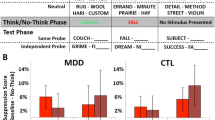Abstract
Depressed patients complain of problems of memory and concentration, and it would be helpful to have a therapeutic procedure capable of reducing or alleviating these problems. The short-term effects of an imagery formation technique were compared with brief relaxation on a range of subjective and objective measures. Imagery formation substantially improved objective memory for a passage of prose, especially in nonendogenous depressives, though it had no comparable effects on subjective measures.
Similar content being viewed by others
References
Alesandrini, K. L. (1982). Imagery—Eliciting strategies and meaningful learning.Journal of Mental Imagery, 6 125–140.
Beck, A. T., Rush, A. J., Shaw, B. F., & Emery, G. (1979).Cognitive therapy of depression. New York: Wiley.
Carr, V., & Smith, J. (1985). Assessment of depression by questionnaire compared to DSM-III diagnosis.Journal of Affective Disorders, 8 167–170.
Cermak, L. S., & Craik, F. I. M. (Eds.). (1979).Levels of processing in human memory. Hillsdale, New Jersey: Erlbaum.
Craik, F. I. M., & Lockhart, R. S. (1972). Level of processing: A framework for memory research.Journal of Verbal Learning and Verbal Behavior, 11 671–684.
Edmunson, E. D., & Nelson, D. L. (1976). Anxiety, imagery and sensory interference.Bulletin of the Psychonomic Society, 8 319–322.
Ellis, H. C., Thomas, R. L., & Rodriguez, I. A. (1984). Emotional mood states and memory: Elaborative encoding, semantic processing and cognitive effort.Journal of Experimental Psychology: Learning Memory and Cognition, 10 470–482.
Fennell, M. J. V., & Teasdale, J. D. (1984). Effects of distraction on thinking and affect in depressed patients.British Journal of Clinical Psychology, 23 65–66.
Fennell, M. J. V., Teasdale, J. D., Jones, S., & Damlé, A. (1987). Distraction in neurotic and endogenous depression: An investigation of negative thinking in major depressive disorders.Psychological Medicine, 17 441–452.
Kahn, R. L., Zarit, S. H., Hilbert, N. M., & Niedervehe, G. (1975). Memory complaint and impairment in the aged.Archives of General Psychiatry, 32 1569–1573.
Kausler, D. H. (1982).Experimental psychology of human aging. New York: Wiley.
Pilowsky, I., & Boulton, D. M. (1970). Development of a questionnaire-based decision rule for classifying depressed patients.British Journal of Psychiatry, 116 647–650.
Powell, G. E. (1981).Brain function therapy. Aldershot, England: Gower.
Richardson, A. (1977). Verbalizer-visualizer: A cognitive style dimension.Journal of Mental Imagery, 1 109–126.
Shallert, D. L. (1976). Improving memory for prose: The relationship between depth of processing and context.Journal of Verbal Learning and Verbal Behavior, 15 621–632.
Spielberger, C. D., Gorsuch, R. L., & Lushene, R. E. (1970).Manual for the State-Trait Anxiety Inventory (Self-evaluation questionnaire). Palo Alto, California: Consulting Psychologists Press.
Teasdale, J. D. (1983). Negative thinking in depression: Cause, effect or reciprocal relationship.Advances in Behaviour Research and Therapy, 5 3–25.
Teasdale, J. D., & Fennell, M. J. V. (1983). Investigating immediate effects on depression of brief interventions: An underused tactic in depression treatment research. In M. Rosenbaum, C. M. Franks, & Y. Jaffe (Eds.),Perspectives on behavior therapy in the eighties. New York: Springer.
Teasdale, J. D., & Rezin, V. (1978). The effects of reducing frequency of negative thoughts on the mood of depressed patients: tests of a cognitive model of depression.British Journal of Social and Clinical Psychology, 17 65–74.
Watts, F. N., & Cooper, Z. (1987).The effects of depression on structural aspects of the recall of prose. Manuscript submitted for publication.
Watts, F. N., & Sharrock, R. (1985). Description and measurement of concentration problems in depressed patients.Psychological Medicine, 15 317–326.
Watts, F. N., & Sharrock, R. (1987). Cued recall in depression.British Journal of Clinical Psychology, 26 149–150.
Weingartner, H., Cohen, R. M., Murphy, D. L., Martello, J., & Gerdt, C. (1981). Cognitive processes in depression.Archives of General Psychiatry, 38 42–47.
Winer, B. J. (1971).Statistical principles in experimental design (2nd ed.). New York: McGraw-Hill.
Author information
Authors and Affiliations
Rights and permissions
About this article
Cite this article
Watts, F.N., MacLeod, A.K. & Morris, L. A remedial strategy for memory and concentration problems in depressed patients. Cogn Ther Res 12, 185–193 (1988). https://doi.org/10.1007/BF01204930
Issue Date:
DOI: https://doi.org/10.1007/BF01204930




